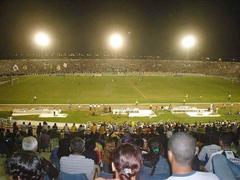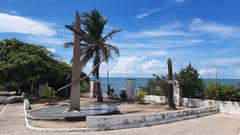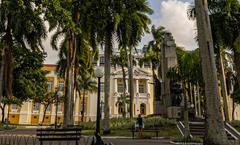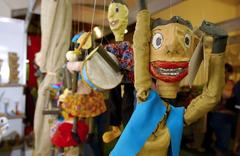Complete Guide to Visiting the Museu da Cidade in João Pessoa: Hours, Tickets, and Top Attractions
Date: 14/06/2025
Introduction
The Museu da Cidade de João Pessoa, nestled in the city’s historic center, is a cultural and historical treasure that offers visitors an immersive journey through João Pessoa’s evolution—from its colonial origins to its vibrant present. Housed in a beautifully restored early 20th-century mansion on Praça da Independência, the museum stands as a guardian of the city’s memory and a dynamic center for cultural engagement. This comprehensive guide provides up-to-date information on visiting hours, ticket policies, accessibility, featured exhibits, and tips for exploring João Pessoa’s other historical sites.
Table of Contents
- Introduction
- Historical Context of João Pessoa and the Museu da Cidade
- Museum Highlights: Exhibitions and Cultural Significance
- The Building: Architecture and Urban Context
- Visitor Information: Hours, Tickets, and Accessibility
- Guided Tours, Events, and Practical Tips
- Nearby Historical Sites and Attractions
- Frequently Asked Questions (FAQ)
- Conclusion
- References
Historical Context of João Pessoa and the Museu da Cidade
Founded in 1585 as Nossa Senhora das Neves, João Pessoa is one of Brazil’s oldest cities. Its strategic location on the Paraíba River made it a key colonial settlement, later renamed several times as power shifted between Portuguese and Dutch rulers. In the 20th century, it was named after João Pessoa Cavalcanti de Albuquerque, a prominent state president whose assassination marked a turning point in Brazilian history (Memória João Pessoa).
The city’s historic core, with its mix of colonial, baroque, and neoclassical architecture, is officially protected, reflecting a commitment to preserving João Pessoa’s layered urban narrative. The Museu da Cidade plays a central role in chronicling and interpreting these transformations for residents and visitors alike.
Museum Highlights: Exhibitions and Cultural Significance
Engaging Exhibitions
The Museu da Cidade offers a fresh approach to historical interpretation through interactive multimedia installations, sensory rooms, and curated displays of personal artifacts, documents, and photographs. Permanent exhibitions include furniture and belongings of João Pessoa Cavalcanti de Albuquerque, such as his work desk and the table linked to his assassination—key artifacts in Brazilian political history (Jornal da Paraíba).
Rotating temporary exhibitions highlight local artists, historical photography, and community-driven projects. The museum also fosters cultural participation through initiatives like web radio and collaborative educational programs (G1 Globo).
Community Engagement
Beyond its exhibits, the museum serves as a vibrant community hub. It offers guided tours, hosts public discussions, and partners with schools and universities. Free admission and thoughtfully designed accessibility features ensure that all visitors—locals and tourists, adults and children—can engage with João Pessoa’s heritage (Museumspedia).
The Building: Architecture and Urban Context
The museum occupies a stately early 20th-century mansion, originally the residence of João Pessoa Cavalcanti de Albuquerque. Its neoclassical and eclectic features—ornate façades, tall windows, high ceilings, and wooden floors—have been carefully preserved and adapted for modern museum use (EAA Architecture). Restoration efforts respected the building’s historical integrity while introducing ramps, adapted restrooms, and interactive technology.
Situated in Praça da Independência, the museum anchors a network of historical and civic spaces, making it an ideal starting point for exploring João Pessoa’s architectural and cultural legacy (Memória João Pessoa).
Visitor Information: Hours, Tickets, and Accessibility
- Location: Praça da Independência, 92, Tambiá, João Pessoa, Paraíba
- Hours: Tuesday to Sunday, 9:00 AM – 5:00 PM (closed Mondays and public holidays)
- Admission: Free for all visitors
- Accessibility: Ramps, adapted restrooms, and tactile displays; trained staff assist visitors with mobility or sensory needs
- Languages: Guided tours available in Portuguese; English and Spanish tours by arrangement (Museumspedia)
- Visitor Amenities: Clean restrooms, Wi-Fi, gift shop, and multilingual information at the reception desk
For updates, consult the official website and Instagram page.
Guided Tours, Events, and Practical Tips
Guided Tours
Enrich your visit with a guided tour led by knowledgeable staff, including participants from educational partnerships. Tours provide deeper context on João Pessoa’s history and the museum’s collections and are available in multiple languages with prior arrangement.
Special Events and Programs
The museum regularly hosts temporary exhibitions, cultural workshops, lectures, and community events. Check the museum’s social media and website for the latest schedule and special programming.
Practical Tips
- Allocate 1–2 hours to fully explore exhibits and interactive displays.
- Combine your visit with a walking tour of the historic center.
- Wear comfortable shoes for cobblestone streets.
- Photography is allowed in most areas (non-flash); restrictions may apply during special exhibitions.
Nearby Historical Sites and Attractions
The Museu da Cidade’s central location places you within walking distance of João Pessoa’s most significant historical and cultural sites:
- São Francisco Church and Cultural Center: Renowned baroque architecture and art galleries
- Museu de Arte Popular da Paraíba: Folk art and crafts
- Teatro Santa Roza: Historic 19th-century theater
- Praça João Pessoa and Palácio da Redenção: Civic landmarks
- Colonial Churches and Plazas: Explore the cobblestone streets and neoclassical buildings of the historic center (WildTrips; G1 PB)
For a broader experience, visit local craft markets, nearby beaches like Tambaú and Cabo Branco, or take a day trip to the historic Forte de Santa Catarina (Brazil City Guides; Trek Zone).
Frequently Asked Questions (FAQ)
Q: What are the Museu da Cidade visiting hours?
A: Tuesday to Sunday, 9:00 AM to 5:00 PM. Closed Mondays and major holidays.
Q: Is there an admission fee?
A: No, entry is free for all visitors.
Q: Are guided tours available?
A: Yes, tours are offered in Portuguese; English and Spanish tours available by arrangement.
Q: Is the museum accessible for people with disabilities?
A: Yes, there are ramps, adapted restrooms, and tactile displays.
Q: Can I take photographs inside?
A: Non-flash photography is generally allowed; some exhibitions may have restrictions.
Q: What other historical sites are nearby?
A: São Francisco Church and Cultural Center, Museu de Arte Popular da Paraíba, Teatro Santa Roza, and various colonial-era landmarks.
Conclusion
The Museu da Cidade de João Pessoa stands as a cornerstone of the city’s cultural landscape—embracing history, fostering community, and making cultural heritage accessible to all. Its interactive exhibits, inclusive facilities, and strategic location in the historic center make it a must-visit for anyone seeking to understand João Pessoa’s unique identity. Enhance your experience by pairing your museum visit with nearby attractions and local events. For updates, special exhibitions, and travel inspiration, follow the museum’s official website and Instagram, and consider using the Audiala app for personalized cultural tips.
References
- Memória João Pessoa
- Jornal da Paraíba
- G1 Globo
- Museumspedia
- Museu da Cidade de João Pessoa official website
- EAA Architecture
- WildTrips
- G1 PB
- Brazil City Guides
- Trek Zone
- Paraíba Criativa



